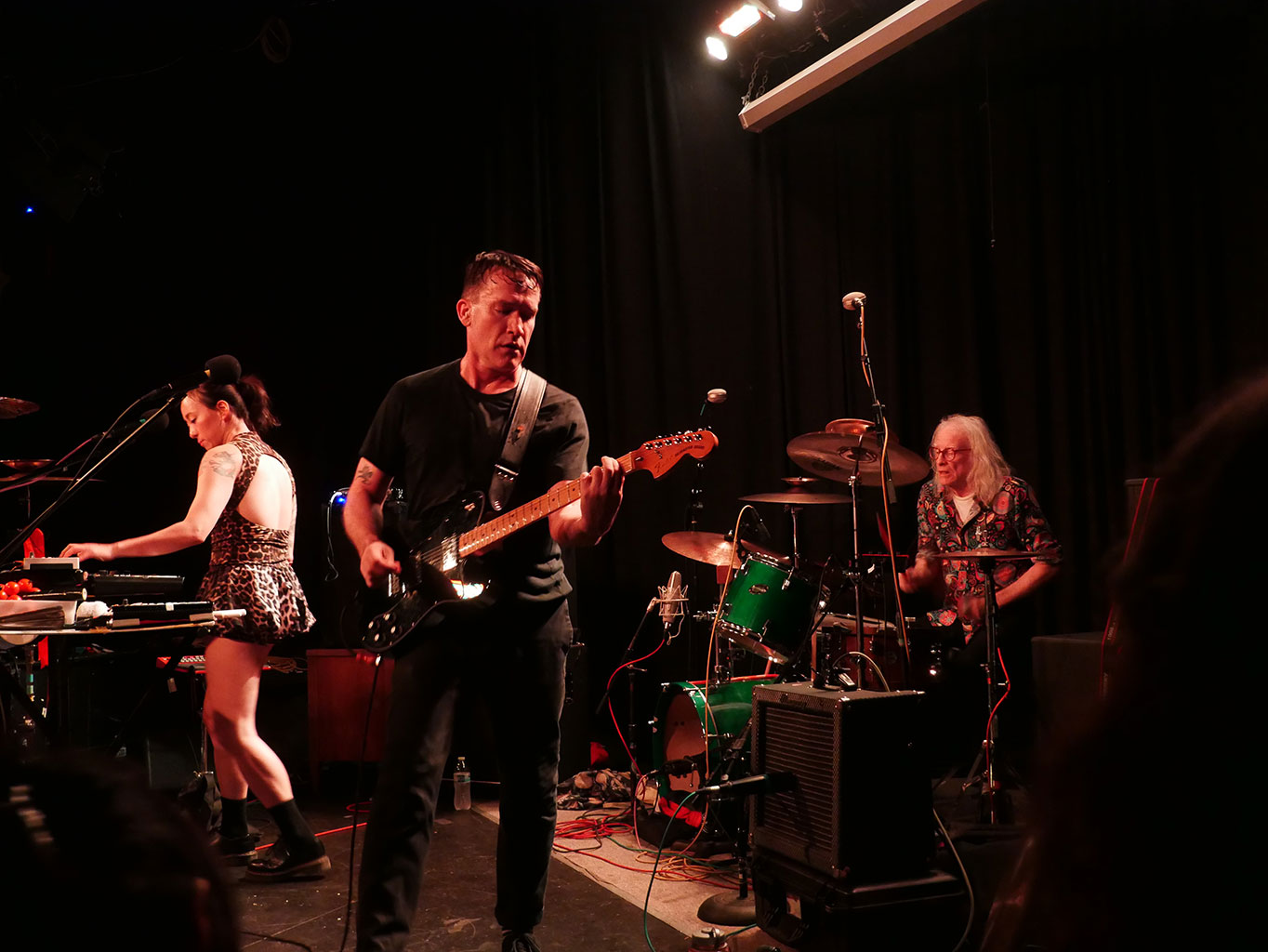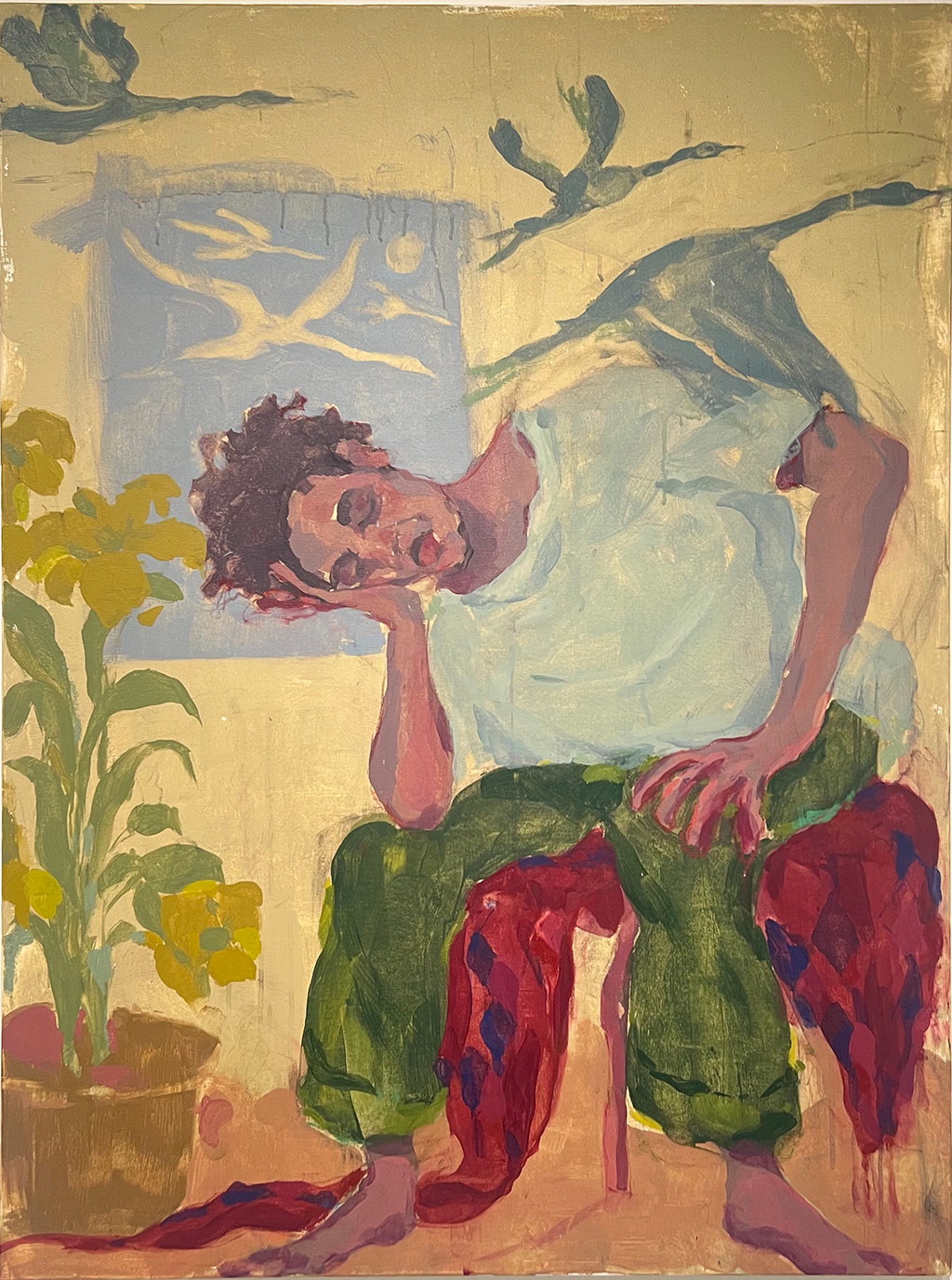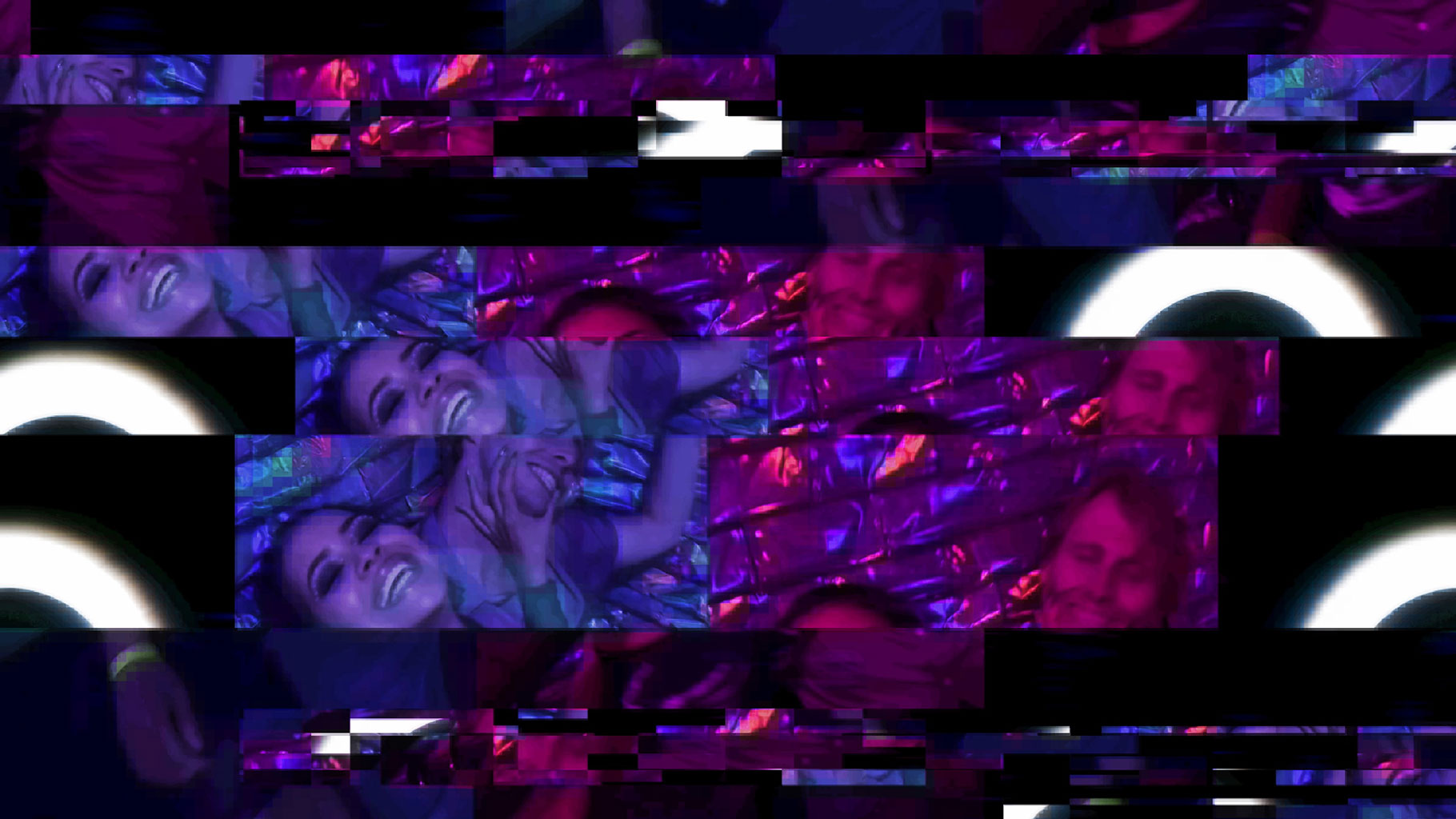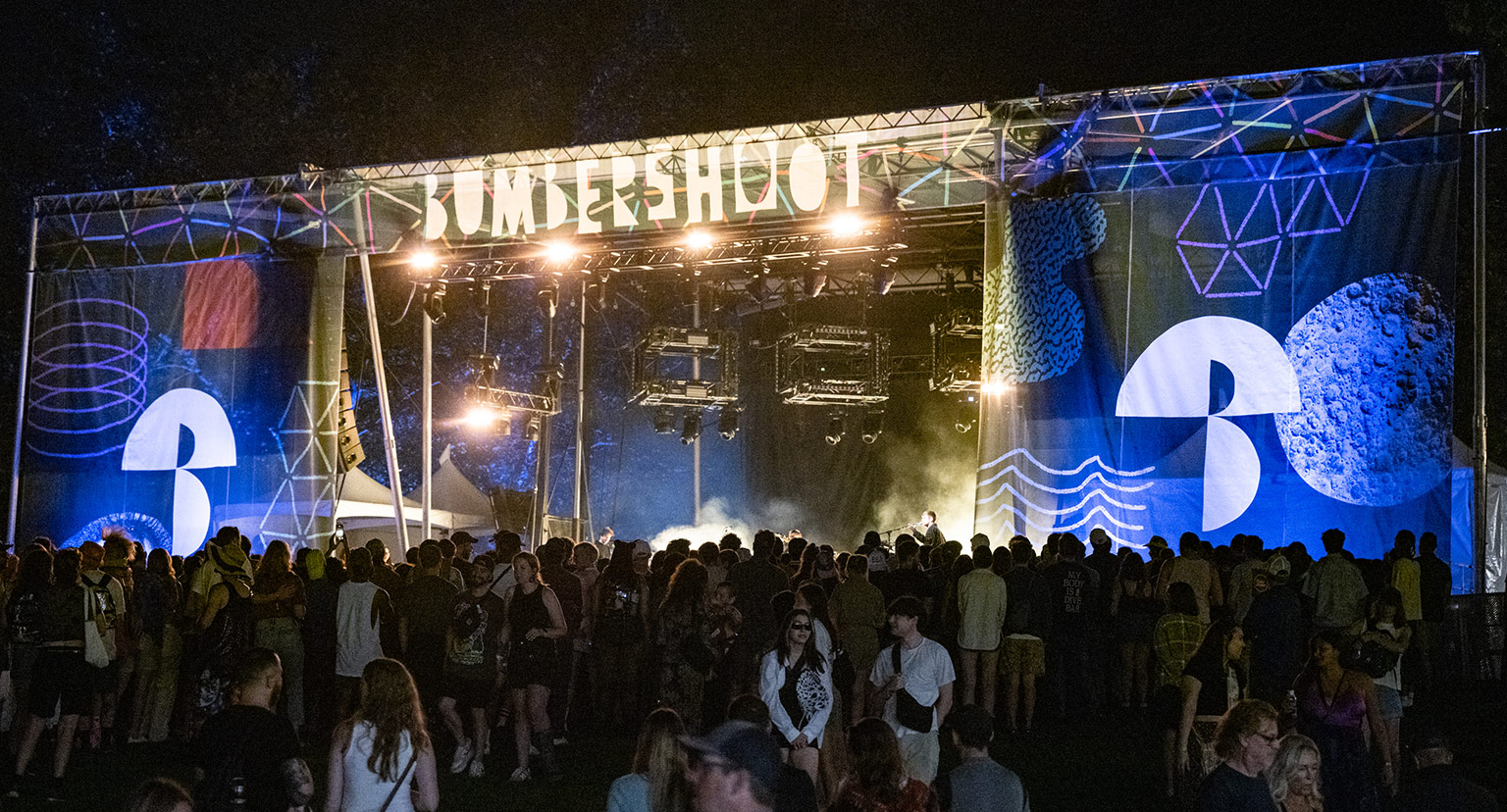Brennan Coyle is one of the newest additions to Seattle’s burgeoning street art scene, and his first solo show, which takes place this month at Snowboard Connection, is proof of his growth. The show will feature a hodge-podge of drawings, paintings, and cut skateboard decks, all modestly priced to sell and to appeal to the fickle Seattle art buyer.
On one particularly overcast afternoon, Coyle sat down with me to a cup of joe and dove into what was to become his first interview ever. He spoke openly on what it’s like to be a growing artist in a rather familial scene, the difference between the art scenes of his hometown in Alaska and Seattle, and the difficulties of solidifying one’s original style after years of trained schooling.
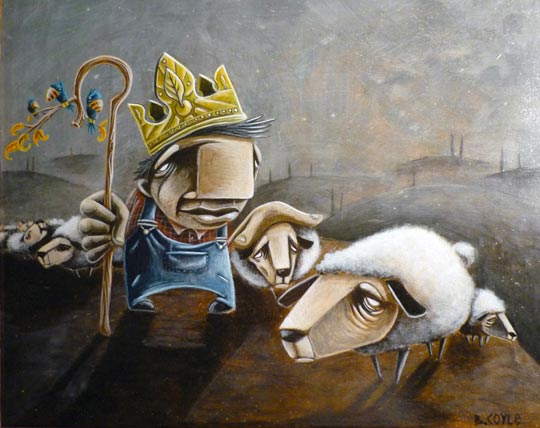
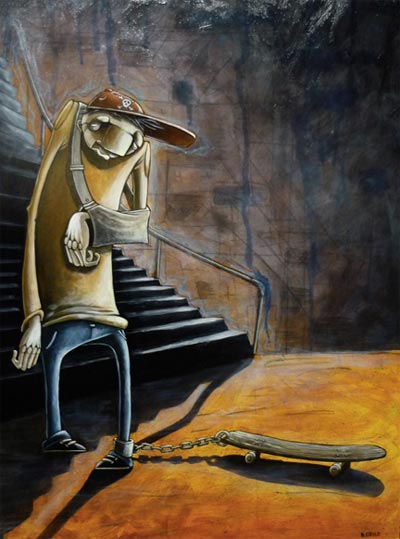 How long have you been in Seattle?
How long have you been in Seattle?
I think five or six years now, [but] I go to Alaska a lot in the summers; that’s where I’m going in April, which I’m kind of bummed on, but I’ll be back.
You’re going for the whole summer, then?
Yeah, the whole summer. Until at least October, I think? So, I’ll get to miss the nice summer down here, experience the crappy Alaskan summer, and come back for the rain. Perfect.
Did you go to school in Seattle, then?
I did. I came down here to go to school at the “prestigious” Art Institute. After about a year of that, I realized it wasn’t really the place for me, but I was too deep into it to get out, or I’d just have wasted a bunch of money, so I kind of just switched all my classes. I was in Animation, and once it left the Drawing classes and dove into 3D Computer Graphics, I worked it out with the Academic Advisor to switch up and take all the illustration classes I could, like Painting — just anything that was more hands-on and not moving pixels around.
So what degree did you end up with?
They gave me an Animation degree, which was kind of weird. Like I said, I did the 2D animation thing, and that was fun. Really, really, really labor-intensive, but it was fun. And once I got into the computer thing, it lost some of its spark. It’s like, “Oh, I click here and I move it there.” It was just too much for me, and I realized I should have gone to a different Illustration school, because [Art Institute] didn’t even have an Illustration program.
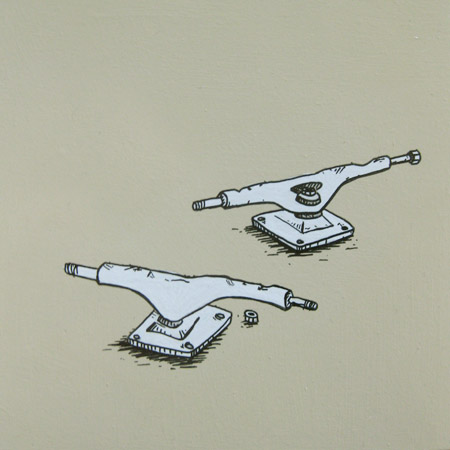 That’s cool that they let you do that.
That’s cool that they let you do that.
Yeah, it was really cool of them, cause there’s a lot of kids who didn’t get to do that, for some reason.
Those who wanted to?
Yeah, a lot of the probably didn’t want to. That’s when a lot of kids really got hyped on it, I think — when it started getting out of the drawing. Surprisingly, you go to an art school and there were not a lot of people who draw really well.
Is there an art scene where you’re from in Alaska at all?
No, there’s not. I always drew and everything, but once I started skating, I started looking into Thrasher magazines and I picked up Juxtapoz … cause there’s nothing in Alaska. They’re like twenty years behind; I think they’re like, just getting internet, maybe. But yeah, once I got into skating, that’s when it kind of picked up; my art scene was me and drawing on my buddies’ skateboards, and [making] notebook doodles throughout class, and failing art class in high school. I didn’t pass an art class until I got to the Art Institute.
Why?
I used to butt heads with my teachers a lot, just on the grounds that they wanted you to draw a 3D cube, and that got kind of boring. It was more just probably my being stubborn, I think. You’re a kid; you kind of do what you want to do. Once I got down here and was like, “Well, I’m paying for it, I may as well do their requirements and then my own thing.” But it was kind of weird; I’m finally just now sifting my style out, just from going to the Art Institute and bouncing around between everything, like, “Okay, you’re going to do a cartoony thing, then you’re going to do a realistic portrait…” and you just get caught in this tornado of them wanting you to do everything. By the end of it, I didn’t even know what I wanted to do. So… it’s nice that it’s finally slowly starting to sift itself out.
Where are you working now?
I’m not. I had one of the greatest jobs ever, working for Vans as a Visual Merchandiser. It sounds horrible, but it was really fun. They gave me a truck and credit cards, and I just had to go around to all the skate shops [in the Northwest] and make sure we look good in there. I got to organize all these little local skate events. It was super fun, [but] it just got a little bit stifling. All I was really doing was working, and I was always on the road. The manager I had — and if this gets published, I kind of hope he reads it — was kind of an asshole, and I finally had enough of it. One day, I decided that I’d never become an artist if I never had time to do it, so I quit. It was a really hard decision because it was a really fun job and I had a lot of great friends and connections through it, but I really had to get out of it if I wanted to do what I really wanted to do. So I did, and I’ve been painting and kind of scraping by the last six months. [It] has been surprising.
“One day, I decided that I’d never become an artist if I never had time to do it, so I quit [my job]. It was a really hard decision because it was a really fun job and I had a lot of great friends and connections through it, but I really had to get out of it if I wanted to do what I really wanted to do.”
— Brennan Coyle
What inspires your style?
Definitely a lot of nature stuff. I do a lot of trees, because trees are kind of cool; they’re so monumental… but [can be] destroyed in seconds a lot of times. I do a lot of nature stuff, and I’ve been doing a lot of these characters that everybody seems to think are sad all the time. It’s just because of the droopy eye thing; most of the time, they’re not supposed to be sad. They’re just kind of supposed to be blank, just because on a day-to-day basis, you don’t see very many really animated people, I guess. Everybody’s just really kind of drab, with no expressions, and I think that’s where it came from. I’m starting to try and work a little smile into it to try and get people away from the, “Man, you’re a really sad guy!” because I’m not! At all! So, like I said, a lot of skating, and all my friends really seem to inspire me a lot, because they’re always doing different stuff, and everybody slowly has their own unique style. A lot of my friends are so developed in their styles now, and they’ve refined them so well, that they’re really fast in doing their pieces and everything is really consistent. It looks good. The painting thing is kind of a battle for me still, but it’s inspiring to see how they’ve developed their styles, and seeing them go from here to where they are now. I’m kind of still all over the place, still. Like, “Oh, I’m going to paint, and then I’m going to do simple drawings…” Eventually, I’m hoping to get faster at doing work and have a more consistent style, so at least it all fits together in a show, instead of, “Is it like, three different artists here?”
Is the Snowboard Connection show your first solo show, then?
It is. I just finally started getting into the art circuit with my friends in the last six months. I’ve done a couple little group shows, and Shaina offered me this Snowboard Connection show, and I said yeah, and now I’m panicking, trying to get everything done. But it’s finally coming together a bit, and I’m really excited to see it.
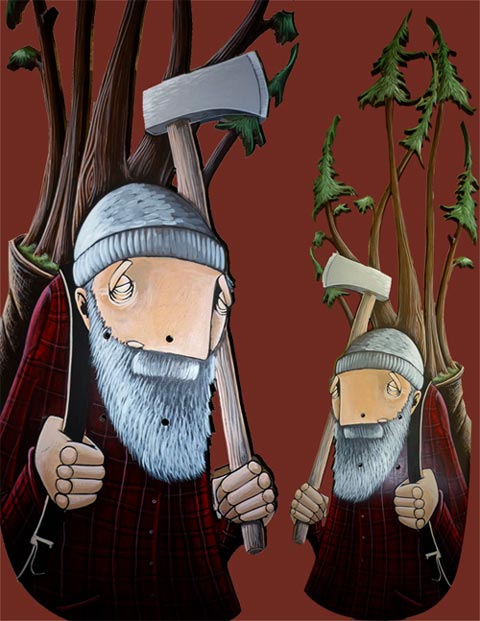 You create cut skate decks that are really starting to take off. Did you get the idea for them from Jeremy Fish, or did they come from somewhere else?
You create cut skate decks that are really starting to take off. Did you get the idea for them from Jeremy Fish, or did they come from somewhere else?
No, fully. I will not even try and hide that. [He’s] definitely where I got the original idea of cutting skateboards. Jeremy Fish does a lot of silhouettes and keeps his cuts pretty simple, and the only way I could figure to get away from trying to be a Jeremy Fish rip-off was to kind of do my own thing with it, and that was to add a little more woodworking into it. I wanted to do it my own way, [so] I’ve ended up doing a lot more really precarious, detailed cuts. With the first [skate deck], it was kind of weird. I think I’d sanded down a deck and I was just going to paint it. I was talking to my friend when we went out to the bar — not to make myself sound like an alcoholic — and we started talking about the cutting-things-out aspect of it. And sure enough, I went home, woke up the next day, and went out to my garage to see that the skateboard was already drawn up and ready to be cut.
By you?
Yes, by me. I didn’t remember doing it, unfortunately, but when I woke up, I was ecstatic, because it was ready to go, so I just kind of went for it. It actually turned out to be my favorite piece. And my friend bought it from me, so it’s nice, because I still get to see it. A lot of the other stuff has just vanished, and I have no idea who has it, or where it went.
Do you have a hard time parting with any of your work?
No. I think the hardest thing was selling my first painting. One of my friends wanted to buy literally the first painting I’d ever done, where it was like, “Okay, yeah, I have an idea of what I’m trying to do,” and it was the first painting I’d done that actually kind of turned out. It was kind of the one I’d envisioned hanging around my house forever, and she wanted it, and I was like, alright, so I sold it to her for cheap. Now it’s in Hawaii or Reno… I don’t know where she’s at now. That was the only one that was kind of hard to part with, and after that, it’s just kind of exciting to see it gone, and I think that’s why I price my stuff so cheap most of the time… cause I’d rather price it cheap and let someone else have it, rather than have a stack of it in my garage.
How’s the pricing for the skateboard decks now?
The skateboards unfortunately have to go up in price. For the two hundred dollar [Cheap Thrills] show, I kept things a little more simple. I didn’t do such intricate cutting and didn’t use as many colors, just because I knew it was a cheap show. Now, there are a lot of people who want them, and I can’t make them fast enough to be cost-effective for two hundred dollars apiece. And I know a couple people who can do a painting in one or two days and then sell it for six hundred dollars. Granted, they’re people with their names out there, and their stuff is more desired, but sometimes I’ll spend a week on these things, and then to sell it for two hundred dollars is like… that was like, four dollars an hour. It was a fun four dollars an hour, but… so, unfortunately, they’ll have to go up a bit. They’ll probably be between four and five [hundred]. The collaboration with [Weirdo] might be six hundred, just because Sam brings a big card to the table and he’s finally starting to get some of the recognition he deserves.
Will there be other collaborations in the future?
This is my first one ever. I’ve never done a collaboration, and I know everybody in this little subculture art world does a lot of them, but I don’t know. I just kind of got into doing show artwork in the last six months, and so far. It’s nice because I’m done, but it’s not finished… it’s like, I’ll do my thing, and now you do your thing, and let’s see what happens.
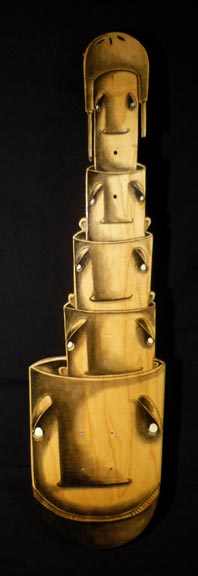 So, are you going to work on art while you’re in Alaska?
So, are you going to work on art while you’re in Alaska?
I am. It’s going to be hard because I’ll be doing fifty hour a week jobs, but I have to, because I feel like I’m finally getting a bit of momentum, and I don’t want to lose that just because I’m going to Alaska. I’m going to try and keep some skateboards coming out, and just basically submit things to group shows, just because it’s an easier task to accomplish. One of my big things is that I’m going to collect a bunch of weird Alaskan stuff and incorporate it into my artwork. I’d like to do an Alaskan theme show when I come back — not so much Alaskan art, but with Alaskan objects… because there’s always so much cool stuff lying around on the beaches.
Examples?
You see a lot of antler art up there, and one of my buddies is like a hunter — well, I guess he’s more like a scavenger who has found a bunch of antlers in the woods — but he called me up the other day and was like, “Dude, I’ve got all these antlers. You should do something on them.” So, I’m going to try and do something on those. I don’t know if I’m going to cut them or paint on them or what, but definitely some antler stuff. There’s lots of cool rusty stuff on the beaches because Alaska’s so lawless that it’s not too uncommon for a truck to get stuck on a beach and just left there for eternity… so there’s a whole bunch of rusty doors and little pieces of metal lying around. I just want to grab some of those and do some paintings on it. I don’t know. I just want to bring back some of the weird wilderness lawlessness of Alaska. There’s just a lot of strange shit lying around, as opposed to down here, where the strangest thing you’ll find is a heroine needle or a Starbucks cup.
That sounds cool.
Yeah, one of my friends is telling me that I should do a show in Alaska, but I don’t think that the town I live in would be too fond of my artwork. It’s like a big Texas in Alaska. They’re not really into skateboard culture at all. I might try and do a small show or something up there, but I don’t really plan to sell any of my stuff. There’s just not a market for low-brow art up there. There’s a huge market for touristy Alaskan style art. If I drew a salmon snatching an eagle and just flipped that on people, it might get some attention. There’s a lot of eagles, moose, wilderness drawings… and that stuff sells like hotcakes.
Is drawing your most preferred medium right now?
It is, for ease of doing it, because I’ve drawn forever and I didn’t start painting until two years ago. [Painting] just started as this off and on thing initially, mostly because I realized that if you want to do an art show [and don’t have] a painting, it loses some of its awe [value]. I love painting; it’s fun. I’m much more ecstatic on a finished painting than a finished drawing, but it’s just so much more work. Like I was saying, many of my friends have a highly refined process where they know what colors they’re going to use, how they’re going to layer stuff, what they need to do to get a certain effect, and I’m still in the woods, in the dark, trying to figure stuff out as I go. So, I do a lot of painting things multiple times. I’ll paint it, and it won’t work, so I’ll buff it, and paint it again. Painting takes a lot of my time, and that’s the pitfall, whereas drawing is something I’ve already figured out for the most part. Not saying I don’t have tons of room for growth, but it’s easier for me, I guess.
You say you want to get to the point where you’ll have a refined style with a set of colors and look that you will be able to reproduce; do you ever think that when you get there it will be stifling in a way?
Like you feel like you’ve built a box around yourself, kinda?
Yeah.
Yeah. I guess the refined thing I’m talking about is kind of creating a consistency where everything goes together. But no, I don’t want to build that box around myself, because I obviously like to mix things up and try new stuff all the time. The only downfall of trying new stuff all the time is that you’re always trying to figure things out as you go… which is a lot of fun, but it’s hard to get good at when you’re just mixing it up. I think I mix it up too much most of the time, and I need to step back and work on certain things more. But yeah, I know what you’re saying, regarding getting trapped in a style and having to do that from there on out, and that if you don’t do that, people don’t really want it or want to see it… [They’ll be] like, “Oh, that’s neat, but why didn’t you do that like your other stuff?” Yeah. I hope it’s not stifling [when I get there].
It’s all about finding a balance, I guess.
Yeah. Having the freedom to do whatever you want but at the same time, having a small set of rules maybe that you can follow that will just help the workflow.
END.


